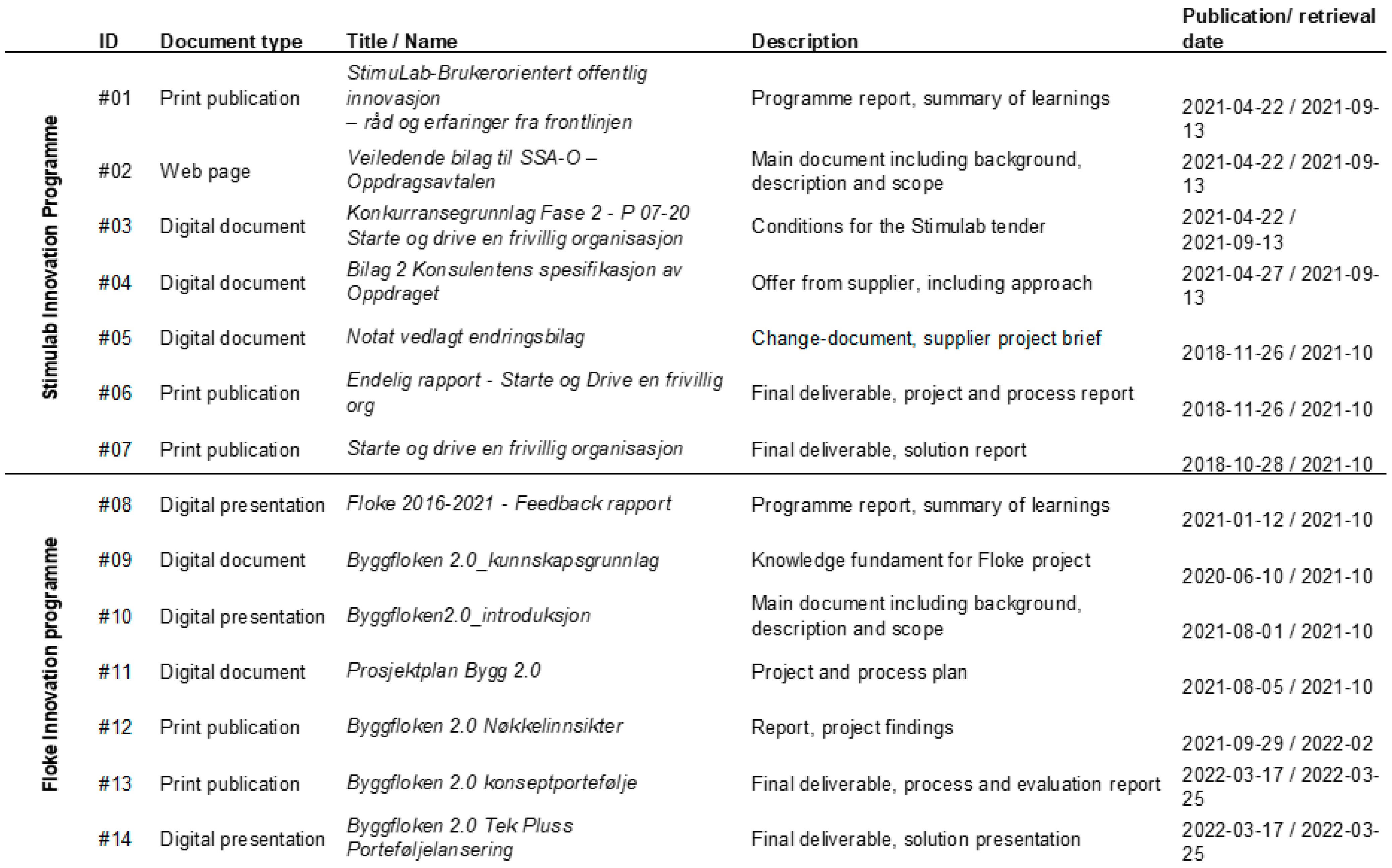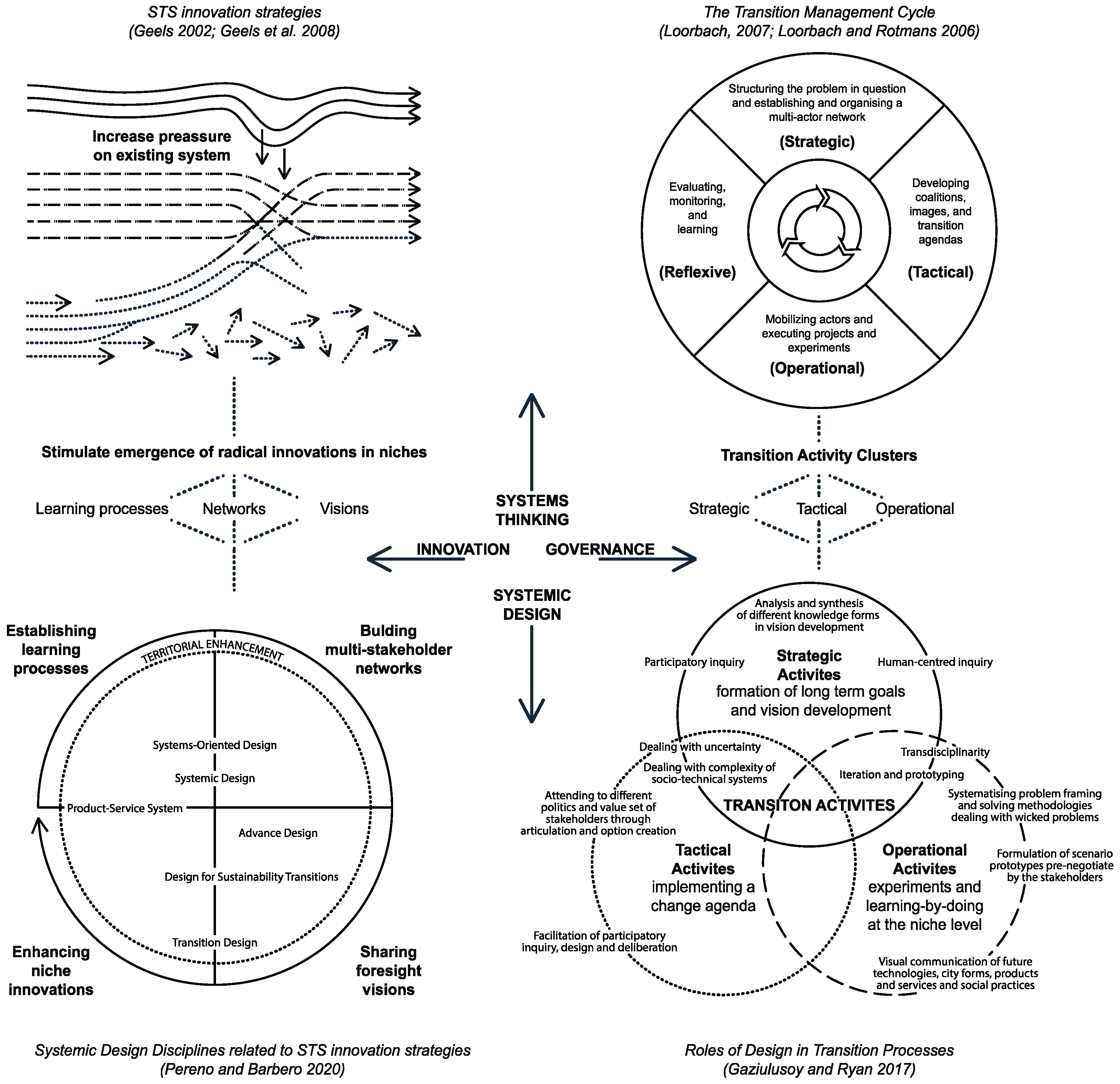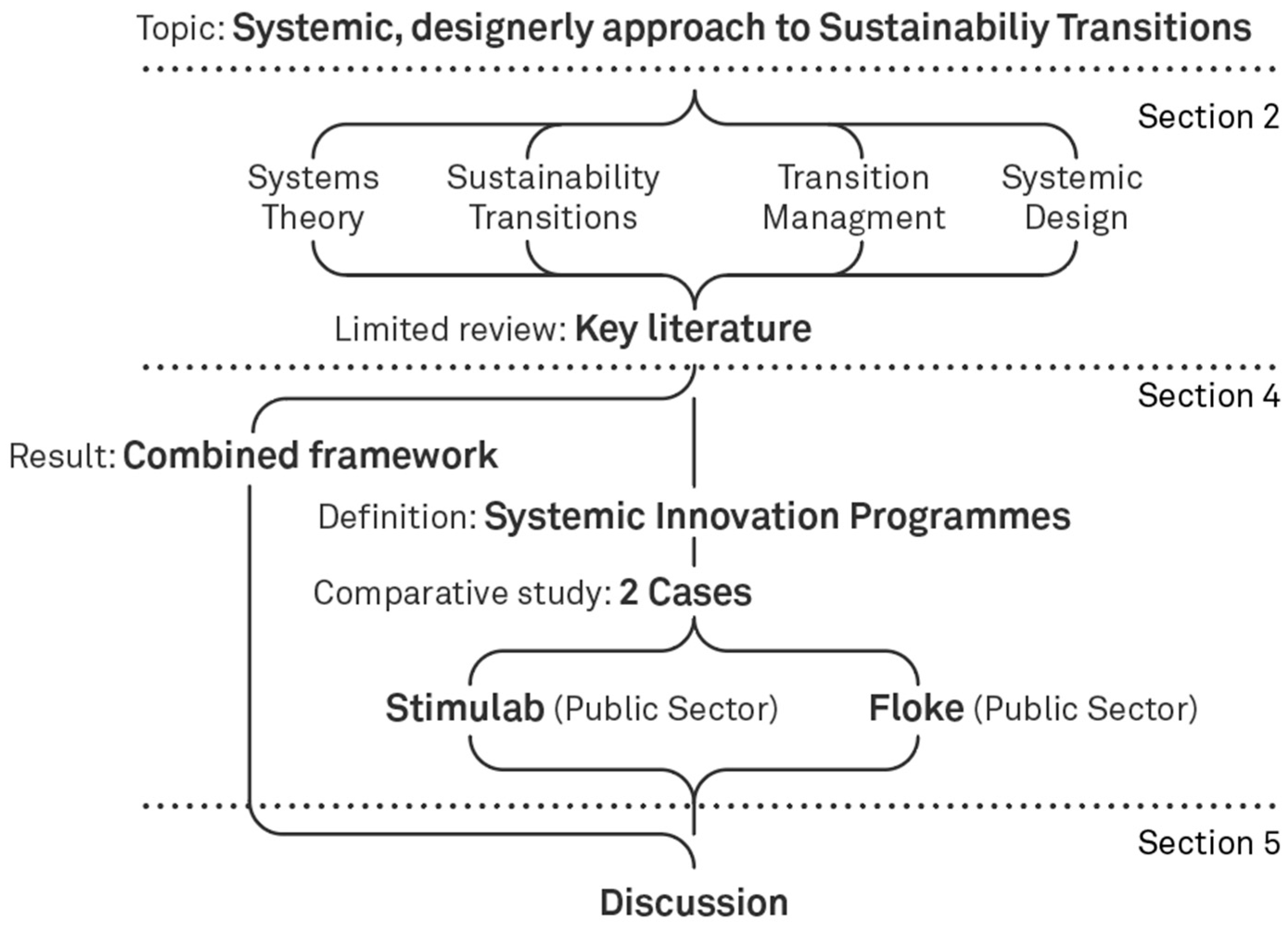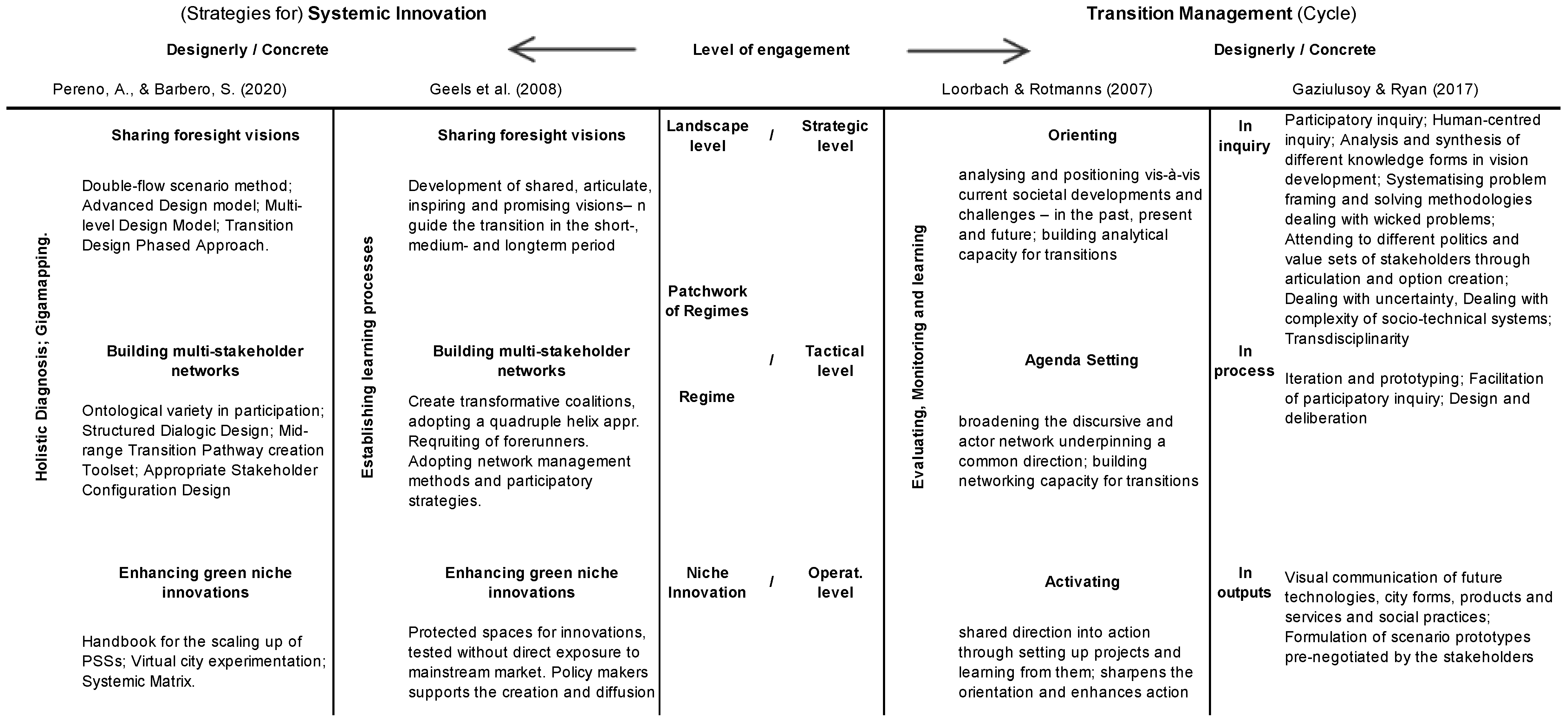Towards Systemic Innovation Programmes for Sustainability Transitions: A Comparative Study of Two Design-Led Cases
Abstract
1. Introduction
2. Theoretical Background
2.1. Systems Theory
2.2. Sustainability Transitions and Transition Management
2.3. Systemic Design and Innovation
2.4. The Emergent Role of Design in Sustainability Transitions
2.5. Synthesising the Key Framework for Evaluating SIPs
2.6. Relating to Transition Management
2.7. Relating to Systemic Innovation
3. Method and Cases
Two Cases of Systemic Innovation, Stimulab, and Floke
4. Results
4.1. A Combined Framework for Comparative Analysis
4.2. Expanding the Concept of Systemic Innovation Programmes
- An open innovation, a responsible initiative [66] that seeks to:
- Organise actors and stakeholders around grand challenges [67].
- Predominantly a multi-actor, cross-sectoral collaboration [68].
- Anticipatory, collective agenda-building for future visions [11] (p. 90).
- A lasting initiative seeking long-term benefit, i.e., learning and evolving capabilities [69], while exploring short-term actions.
- A set of repeatable structural elements (to predict outcomes and minimise risks), such as projects with prescribed forms, boundaries, and tangible deliverables:
- That works synergistically to effect systemic change [62].
4.3. Comparative Analysis of Stimulab and Floke
4.4. General Consideration of the Cases Relating to Transferability and Applicability
5. Discussion
5.1. Project Initiation and Framing from the Systemic Programmes
5.2. Process and Methodological Rationale
5.3. Stakeholder Identification and Inclusion
5.4. Establishing Learning Processes, Evaluating, and Monitoring
5.5. Addressing the Landscape/Strategic Level
5.6. Addressing the Regime/Tactical Level
5.7. Addressing the Niche/Operational Level
6. Conclusions
Funding
Institutional Review Board Statement
Informed Consent Statement
Data Availability Statement
Conflicts of Interest
Appendix A

References
- IPCC. IPCC, AR6: Summary for Policymakers; No. 6; Climate Change 2022: Impacts, Adaptation, and Vulnerability. Contribution of Working Group II to the Sixth Assessment Report of the Intergovernmental Panel on Climate Change; IPCC—Intergovernmental Panel on Climate Change: Geneva, Switzerland, 2022.
- Steffen, W.; Richardson, K.; Rockström, J.; Cornell, S.E.; Fetzer, I.; Bennett, E.M.; Biggs, R.; Carpenter, S.R.; Vries, W.; de Wit, C.A.; et al. Planetary boundaries: Guiding human development on a changing planet. Science 2015, 347, 1259855. [Google Scholar] [CrossRef]
- Holling, C.S. Understanding the Complexity of Economic, Ecological, and Social Systems. Ecosystems 2001, 4, 390–405. [Google Scholar] [CrossRef]
- Sveiby, K.-E.; Gripenberg, P.; Segercrantz, B.; Eriksson, A.; Aminoff, A. Unintended and Undesirable Consequences of Innovation. In Proceedings of the XX ISPIM Conference, Vienna, Austria, 21–24 June 2009; Available online: https://researchportal.helsinki.fi/en/publications/unintended-and-undesirable-consequences-of-innovation (accessed on 4 April 2023).
- Raworth, K. A Doughnut for the Anthropocene: Humanity’s compass in the 21st century. Lancet Planet. Health 2017, 1, e48–e49. [Google Scholar] [CrossRef] [PubMed]
- Grin, J.; Rotmans, J.; Schot, J. Transitions to Sustainable Development: New Directions in the Study of Long Term Transformative Change; Routledge: New York, NY, USA, 2010. [Google Scholar] [CrossRef]
- Loorbach, D.; Frantzeskaki, N.; Avelino, F. Sustainability Transitions Research: Transforming Science and Practice for Societal Change. Annu. Rev. Environ. Resour. 2017, 42, 599–626. [Google Scholar] [CrossRef]
- Markard, J.; Raven, R.; Truffer, B. Sustainability transitions: An emerging field of research and its prospects. Res. Policy 2012, 41, 955–967. [Google Scholar] [CrossRef]
- Köhler, J.; Geels, F.W.; Kern, F.; Markard, J.; Onsongo, E.; Wieczorek, A.; Alkemade, F.; Avelino, F.; Bergek, A.; Boons, F.; et al. An agenda for sustainability transitions research: State of the art and future directions. Environ. Innov. Soc. Transit. 2019, 31, 1–32. [Google Scholar] [CrossRef]
- Rauschmayer, F.; Bauler, T.; Schäpke, N. Towards a thick understanding of sustainability transitions—Linking transition management, capabilities and social practices. Ecol. Econ. 2015, 109, 211–221. [Google Scholar] [CrossRef]
- Loorbach, D. Transition Management: New Mode of Governance for Sustainable Development; Erasmus University Rotterdam: Rotterdam, The Netherlands, 2007; Volume 193, Available online: hdl.handle.net/1765/10200 (accessed on 7 November 2022).
- Sevaldson, B.; Jones, P. An Interdiscipline Emerges: Pathways to Systemic Design. She Ji J. Des. Econ. Innov. 2020, 5, 75–84. [Google Scholar] [CrossRef]
- Banathy, B.H. Designing Social Systems in a Changing World; Springer Science & Business Media: Berlin, Germany, 1996. [Google Scholar]
- Cross, N. Designerly Ways of Knowing. In Designerly Ways of Knowing; Springer: London, UK, 2006; Volume 3. [Google Scholar] [CrossRef]
- Schön, D. The Reflective Practitioner—How Professionals Think in Action; Routledge: London, UK, 1992. [Google Scholar] [CrossRef]
- Dorst, K. The core of ‘design thinking’ and its application. Des. Stud. 2011, 32, 521–532. [Google Scholar] [CrossRef]
- Lehmann, M.; Bocken, N.; Steingrimsson, J.; Evans, S. Incorporating Designing Thinking into Sustainable Business Modelling. InImpact J. Innov. Impact 2016, 8, 297. [Google Scholar]
- Stamm, B. von Innovation—What’s Design Got to Do with It? Des. Manag. Rev. 2004, 15, 10–19. [Google Scholar] [CrossRef]
- Battistoni, C.; Giraldo Nohra, C.; Barbero, S. A Systemic Design Method to Approach Future Complex Scenarios and Research Towards Sustainability: A Holistic Diagnosis Tool. Sustainability 2019, 11, 4458. [Google Scholar] [CrossRef]
- Buhl, A.; Schmidt-Keilich, M.; Muster, V.; Blazejewski, S.; Schrader, U.; Harrach, C.; Schäfer, M.; Süßbauer, E. Design thinking for sustainability: Why and how design thinking can foster sustainability-oriented innovation development. J. Clean. Prod. 2019, 231, 1248–1257. [Google Scholar] [CrossRef]
- Ceschin, F.; Gaziulusoy, I. Evolution of design for sustainability: From product design to design for system innovations and transitions. Des. Stud. 2016, 47, 118–163. [Google Scholar] [CrossRef]
- Van Huijstee, M.M.; Francken, M.; Leroy, P. Partnerships for sustainable development: A review of current literature. Environ. Sci. 2007, 4, 75–89. [Google Scholar] [CrossRef]
- Adams, R.; Jeanrenaud, S.; Bessant, J.; Denyer, D.; Overy, P. Sustainability-oriented Innovation: A Systematic Review. Int. J. Manag. Rev. 2016, 18, 180–205. [Google Scholar] [CrossRef]
- Dyllick, T.; Hockerts, K. Beyond the Business Case for Corporate Sustainability. Bus. Strateg. Environ. 2002, 11, 130–141. [Google Scholar] [CrossRef]
- Loorbach, D. Transition Management for Sustainable Development: A Prescriptive, Complexity-Based Governance Framework. Governance 2010, 23, 161–183. [Google Scholar] [CrossRef]
- Geels, F.W. Technological transitions as evolutionary reconfiguration processes: A multi-level perspective and a case-study. Res. Policy 2002, 31, 1257–1274. [Google Scholar] [CrossRef]
- Kemp, R.; Schot, J.; Hoogma, R. Regime shifts to sustainability through processes of niche formation: The approach of strategic niche management. Technol. Anal. Strateg. Manag. 1998, 10, 175–198. [Google Scholar] [CrossRef]
- Clayton, T.; Radcliffe, N. Sustainability: A Systems Approach; Routledge: London, UK, 1996. [Google Scholar] [CrossRef]
- Ackoff, R.L. Systems thinking and thinking systems. Syst. Dyn. Rev. 1994, 10, 175–188. [Google Scholar] [CrossRef]
- Adams, K.; Hester, P.; Bradley, J. A historical perspective of systems theory. In IIE Annual Conference and Expo 2013; Institute of Industrial and Systems Engineers: Peachtree Corners, GA, USA, 2013; pp. 4102–4109. [Google Scholar]
- Checkland, P. Systems Thinking, Systems Practice: Includes a 30-Year Retrospective; Wiley: Hoboken, NJ, USA, 1999. [Google Scholar]
- Rip, A.; Kemp, R. Technological change. In Human Choice and Climate Change: Vol. II, Resources and Technology; Battelle Press: Columbus, OH, USA, 1998; pp. 327–399. [Google Scholar] [CrossRef]
- Garud, R.; Gehman, J. Metatheoretical Perspectives on Sustainability Journeys: Evolutionary, Relational and Durational. Res. Policy 2012, 41, 980–995. [Google Scholar] [CrossRef]
- Smith, A.; Stirling, A.; Berkhout, F. The governance of sustainable socio-technical transitions. Res. Policy 2005, 34, 1491–1510. [Google Scholar] [CrossRef]
- Loorbach, D.; Frantzeskaki, N.; Huffenreuter, R.L. Transition Management: Taking Stock from Governance Experimentation. J. Corp. Citizsh. 2015, 58, 48–66. [Google Scholar] [CrossRef]
- Loorbach, D.; Bakel, J.; Whiteman, G.; Rotmans, J. Business strategies for transitions to sustainable systems. Bus. Strategy Environ. 2009, 19, 133–146. [Google Scholar] [CrossRef]
- Jones, P.; Kijima, K. Systemic Design: Theory, Methods, and Practice; Springer: Berlin, Germany, 2018. [Google Scholar] [CrossRef]
- Krippendorff, K. The Semantic Turn: A New Foundation for Design; CRC Press: Boca Raton, FL, USA, 2005. [Google Scholar] [CrossRef]
- Glanville, R. Designing Complexity. In Perform. Improv. Q.; 2007; Volume 20, pp. 75–96. [Google Scholar] [CrossRef]
- Sevaldson, B. Systems Oriented Design: The Emergence and Development of a Designerly Approach to Address Complexity; May 14 2013.
- Meadows, D. Thinking in Systems: A Primer; Chelsea Green Publishing: Chelsea, VT, USA, 2008. [Google Scholar]
- Colvin, J.; Blackmore, C.; Chimbuya, S.; Collins, K.; Dent, M.; Goss, J.; Ison, R.; Roggero, P.P.; Seddaiu, G. In search of systemic innovation for sustainable development: A design praxis emerging from a decade of social learning inquiry. Res. Policy 2014, 43, 760–771. [Google Scholar] [CrossRef]
- Gaziulusoy, I.; Brezet, H. Design for system innovations and transitions: A conceptual framework integrating insights from sustainablity science and theories of system innovations and transitions. J. Clean. Prod. 2015, 108, 558–568. [Google Scholar] [CrossRef]
- Norman, D.; Stappers, P.J. DesignX: Complex Socio-technical Systems. She Ji J. Des. Econ. Innov. 2016, 1, 83–106. [Google Scholar] [CrossRef]
- Ceschin, F. How the Design of Socio-technical Experiments Can Enable Radical Changes for Sustainability. Int. J. Des. 2014, 8, 1–21. [Google Scholar]
- Joore, P.; Brezet, H. A Multi-level Design Model—The Mutual Relationship between Product-Service System Development and Societal Change Processes. J. Clean. Prod. 2014, 97, 92–105. [Google Scholar] [CrossRef]
- Owoyele, B.; Edelman, J. Deep Design: Integrating Transitions Research and Design with Agency, in the Digital Era. Available online: https://www.researchgate.net/publication/350941789_Deep_Design_Integrating_Transitions_Research_and_Design_with_Agency_in_the_Digital_Era (accessed on 26 March 2021).
- Ceschin, F. The Role of Socio-Technical Experiments in Introducing Sustainable Product-Service System Innovations. In The Handbook of Service Innovation; Agarwal, R., Selen, W., Roos, G., Green, R., Eds.; Springer: Berlin, Germany, 2015; pp. 373–401. [Google Scholar] [CrossRef]
- Öztekin, E.E.; Gaziulusoy, İ. Co-positioning design for sustainability transitions, practice theory and transitions theories: Towards dialogue and collaboration. J. Des. Res. 2020, 18, 196–223. [Google Scholar] [CrossRef]
- Irwin, T. The Emerging Transition Design Approach. Ensayos 2018, 73, 147–179. [Google Scholar]
- Gaziulusoy; Ryan, C. Roles of design in sustainability transitions projects: A case study of Visions and Pathways 2040 project from Australia. J. Clean. Prod. 2017, 162, 1297. [Google Scholar] [CrossRef]
- Geels, F.; Eames, M.; Steward, F.; Monaghan, A. The feasibility of systems thinking in sustainable consumption and production policy: A report to the Department for Environment, Food and Rural Affairs. Undefined. 2008. Available online: https://randd.defra.gov.uk/ProjectDetails?ProjectId=14603 (accessed on 14 June 2022).
- Pereno, A.; Barbero, S. Systemic design for territorial enhancement: An overview on design tools supporting socio-technical system innovation. Strateg. Des. Res. J. 2020, 13, 113–136. [Google Scholar] [CrossRef]
- Geels, F.W.; Schot, J. Typology of socio-technical transition pathways. Res. Policy 2007, 36, 399–417. [Google Scholar] [CrossRef]
- Myers, M. Qualitative Research in Information Systems. MIS Q. 1997, 21, 241–242. [Google Scholar] [CrossRef]
- Merriam, S.B. Qualitative Research and Case Study Applications in Education: Revised and Expanded from Case Study Research in Education; 2nd Revised & Expanded edition; Jossey-Bass: Hoboken, NJ, USA, 1998. [Google Scholar]
- Atkinson, P.A.; Coffey, A.J. Analysing documentary realities. In Qualitativeresearch: Theory, Method and Practice; Silverman, D., Ed.; Sage Publications Ltd.: Thousand Oak, CA, USA, 1997; pp. 45–62. Available online: https://orca.cardiff.ac.uk/id/eprint/26383/ (accessed on 29 January 2023).
- Dalsgaard, P. Pragmatism and Design Thinking. Int. J. Des. 2014, 8, 143–155. [Google Scholar]
- Sevaldson, B. Redesigning Systems Thinking. Akad.-Forsk. Des. Og Des. 2017, 10, 1–23. [Google Scholar] [CrossRef]
- DigDir; DOGA. Brukerorientert Offentlig Innovasjon. 2020. Available online: https://www.digdir.no/media/887/download (accessed on 14 December 2022).
- Maylor, H.; Brady, T.; Cooke-Davies, T.; Hodgson, D. From projectification to programmification. Int. J. Proj. Manag. 2006, 24, 663–674. [Google Scholar] [CrossRef]
- Pellegrinelli, S. What’s in a name: Project or programme? Int. J. Proj. Manag. 2011, 29, 232–240. [Google Scholar] [CrossRef]
- Van Patter, G. Rethinking Design Thinking: Making Sense of the Future That Has Already Arrived; Humantific: New York, NY, USA, 2020. [Google Scholar]
- Janssen, M.J.; Bergek, A.; Wesseling, J.H. Evaluating systemic innovation and transition programmes: Towards a culture of learning. PLOS Sustain. Transform. 2022, 1, e0000008. [Google Scholar] [CrossRef]
- Medina-García, C.; Nagarajan, S.; Castillo-Vysokolan, L.; Béatse, E.; Van den Broeck, P. Innovative Multi-Actor Collaborations as Collective Actors and Institutionalised Spaces. The Case of Food Governance Transformation in Leuven (Belgium). Front. Sustain. Food Syst. 2022, 5, 788934. Available online: https://www.frontiersin.org/articles/10.3389/fsufs.2021.788934 (accessed on 4 April 2023). [CrossRef]
- Vanhaverbeke, W. The interorganizational context of open innovation. In Open Innovation: Researching a New Paradigm; Oxford University Press: Oxford, UK, 2006; pp. 205–219. [Google Scholar]
- Ferraro, F.; Etzion, D.; Gehman, J. Tackling Grand Challenges Pragmatically: Robust Action Revisited. Organ. Stud. 2015, 36, 363–390. Available online: https://papers.ssrn.com/abstract=2516763 (accessed on 4 April 2023). [CrossRef]
- Schütz, F.; Heidingsfelder, M.L.; Schraudner, M. Co-shaping the Future in Quadruple Helix Innovation Systems: Uncovering Public Preferences toward Participatory Research and Innovation. She Ji J. Des. Econ. Innov. 2019, 5, 128–146. [Google Scholar] [CrossRef]
- Van Poeck, K.; Östman, L.; Block, T. Opening up the black box of learning-by-doing in sustainability transitions. Environ. Innov. Soc. Transit. 2020, 34, 298–310. [Google Scholar] [CrossRef]
- Arnstein, S.R. A Ladder Of Citizen Participation. J. Am. Inst. Plan. 1969, 35, 216–224. [Google Scholar] [CrossRef]
- Wiek, A.; Bernstein, M.; Foley, R.; Cohen, M.; Forrest, N.; Kuzdas, C.; Kay, B.; Keeler, L. Operationalising Competencies in Higher Education for Sustainable Development. In Routledge Handbook of Higher Education for Sustainable Development; Routledge: Abingdon-on-Thames, UK, 2016; pp. 241–260. Available online: https://www.taylorfrancis.com/chapters/edit/10.4324/9781315852249-20 (accessed on 3 December 2022).
- Mazzucato, M. Mission-oriented innovation policies: Challenges and opportunities. Ind. Corp. Chang. 2018, 27, 803–815. [Google Scholar] [CrossRef]
- Farla, J.; Markard, J.; Raven, R.; Coenen, L. Sustainability transitions in the making: A closer look at actors, strategies and resources. Technol. Forecast. Soc. Chang. 2012, 79, 991–998. [Google Scholar] [CrossRef]
- von Thienen, J.; Meinel, C.; Nicolai, C. How Design Thinking Tools Help To Solve Wicked Problems. In Design Thinking Research: Building Innovation Ecosystems; Springer Science & Business Media: Berlin/Heidelberg, Germany, 2013; pp. 97–102. [Google Scholar] [CrossRef]
- Rittel, H.W.J.; Webber, M.M. Dilemmas in a general theory of planning. Policy Sci. 1973, 4, 155–169. [Google Scholar] [CrossRef]
- Özbekhan, H. The Predicament of Mankind: Quest for Structured Responses to Growing World-wide Complexities and Uncertainties-a Proposal; Management and Behavioral Science Center, University of Pennsylvania: Philadelphia, PA, USA, 1970. [Google Scholar]
- Geels, F.; Schot, J. The Dynamics of Transitions: A Socio-Technical Perspective; Routledge New York: New York, NY, USA, 2010; pp. 11–104. [Google Scholar]
- WCED. Our Common Future; Oxford University Press: Oxford, UK, 1987. [Google Scholar]
- Elkington, J. Partnerships from cannibals with forks: The triple bottom line of 21st-century business. Environ. Qual. Manag. 1998, 8, 37–51. [Google Scholar] [CrossRef]
- Bason, C. Leading Public Sector Innovation (Second Edition): Co-Creating for a Better Society; REV-Revised, 2; Bristol University Press: Bristol, UK, 2018. [Google Scholar] [CrossRef]
- Chesbrough, H. The role of the business model in capturing value from innovation: Evidence from Xerox Corporation’s technology spin-off companies. Ind. Corp. Chang. 2002, 11, 529–555. [Google Scholar] [CrossRef]
- Porter, M.E.; Kramer, M.R. Creating shared value. Harv. Bus. Rev. 2011, 89, 62–77. [Google Scholar]
- Brown, T. Design thinking. Harv. Bus. Rev. 2008, 86, 84—92+141. [Google Scholar] [PubMed]
- Osterwalder, A.; Pigneur, Y.; Tucci, C.L. Clarifying Business Models: Origins, Present, and Future of the Concept. Commun. Assoc. Inf. Syst. 2005, 16, 1. [Google Scholar] [CrossRef]
- Madsbjerg, C. Sensemaking: The Power of the Humanities in the Age of the Algorithm; Hachette Books: New York, NY, USA, 2017. [Google Scholar]
- Weick, K.E. Sensemaking in Organizations, 1st ed.; SAGE Publications, Inc.: Thousand Oak, CA, USA, 1995. [Google Scholar]
- Kimbell, L. Rethinking Design Thinking: Part I. Des. Cult. 2011, 3, 285–306. [Google Scholar] [CrossRef]
- Guilford, J.P. Creativity: Yesterday, today, and tomorrow. J. Creat. Behav. 1967, 1, 3–14. [Google Scholar] [CrossRef]
- Design Council. A Study of the Design Process. 2005. p. 144. Available online: https://www.designcouncil.org.uk/our-work/news-opinion/double-diamond-universally-accepted-depiction-design-process/ (accessed on 30 January 2023).
- Govindarajan, V. The Three-Box Solution: A Strategy for Leading Innovation; Harvard Business Review Press: Brighton, MA, USA, 2016. [Google Scholar]
- Siggelkow, N. Persuasion With Case Studies. Acad. Manag. J. 2007, 50, 20–24. [Google Scholar] [CrossRef]
- Yin, R.K. Case Study Research; SAGE Publications: Thousand Oak, CA, USA, 2014. [Google Scholar]
- VanPatter; Pastor, E. Innovation Methods Mapping: De-mystifying 80+ Years of Innovation Process Design; CreateSpace Independent Publishing Platform: Scotts Valley, CA, USA, 2016. [Google Scholar]
- Bogers, M.; Chesbrough, H. Sustainable Open Innovation to Address a Grand Challenge: Lessons from Carlsberg and the Green Fiber Bottle. Br. Food J. 2020, 122, 1505–1517. [Google Scholar] [CrossRef]
- Chesbrough, H. Business Model Innovation: Opportunities and Barriers. Long Range Plan. 2010, 43, 354–363. [Google Scholar] [CrossRef]
- Kemp, R.; Loorbach, D.; Rotmans, J. Transition management as a model for managing processes of co-evolution towards sustainable development. Int. J. Sustain. Dev. World Ecol. 2007, 14, 78–91. [Google Scholar] [CrossRef]
- Velter, M.G.E.; Bitzer, V.; Bocken, N.M.P. A Boundary Tool for Multi-stakeholder Sustainable Business Model Innovation. Circ. Econ. Sustain. 2022, 2, 401–431. [Google Scholar] [CrossRef] [PubMed]
- Kolb, D. Experiential Learning: Experience As The Source Of Learning And Development. In Journal of Business Ethics; FT Press: Upper Saddle River, NJ, USA, 1984; Volume 1. [Google Scholar]
- Alhola, K.; Ryding, S.-O.; Salmenperä, H.; Busch, N.J. Exploiting the potential of public procurement: Opportunities for circular economy. J. Ind. Ecol. 2019, 23, 96–109. [Google Scholar] [CrossRef]
- Mwesiumo, D.; Olsen, K.M.; Svenning, G.A.; Glavee-Geo, R. Implementing public procurement of innovations in an organisation: Lessons from Norway. J. Public Procure. 2019, 19, 252–274. [Google Scholar] [CrossRef]
- Sevaldson, B. Visualising Complex Design: The Evolution of Gigamaps. In Systemic Design: Theory, Methods, and Practice; Jones, P., Kijima, K., Eds.; Springer: Tokyo, Japan, 2018; pp. 243–269. [Google Scholar] [CrossRef]
- Neuhoff, R.; Simeone, L.; Holst Laursen, L. The potential of design-driven futuring to support strategising for sustainable futures. Des. J. 2022, 25, 955–975. [Google Scholar] [CrossRef]
- Weigand, K.; Flanagan, T.; Dye, K.; Jones, P. Collaborative foresight: Complementing long-horizon strategic planning. Technol. Forecast. Soc. Chang. 2014, 85, 134–152. [Google Scholar] [CrossRef]
- Raven, R.; Van den Bosch, S.; Weterings, R. Transitions and strategic niche management: Towards a competence kit for practitioners. Int. J. Technol. Manag. 2010, 51, 57–74. [Google Scholar] [CrossRef]
- Boons, F.; Lüdeke-Freund, F. Business Models for Sustainable Innovation: State of the Art and Steps Towards a Research Agenda. J. Clean. Prod. 2012, 45, 9–19. Available online: https://papers.ssrn.com/abstract=2103495 (accessed on 27 April 2023). [CrossRef]
- Schaltegger, S.; Hansen, E.G.; Lüdeke-Freund, F. Business Models for Sustainability: Origins, Present Research, and Future Avenues. Organ. Environ. 2015, 29, 3–10. [Google Scholar] [CrossRef]
- Bocken, N.; Boons, F.; Baldassarre, B. Sustainable business model experimentation by understanding ecologies of business models. J. Clean. Prod. 2019, 208, 1498–1512. [Google Scholar] [CrossRef]



| Programme Aspects | Stimulab | Floke |
|---|---|---|
| Rationale | Stimulating experimental approaches to grow innovation capacities in the public sector and strengthening collaboration with private-sector suppliers. | Sustainability Oriented Innovation through multi-actor cooperation for addressing societal-scale challenges by activating resources and competencies in the private sector. |
| Programme Ownership | Governmental; Norwegian Architecture and Design (DOGA), Directorate for digitalisation (DigDir). | Privately held; Æra Strategic Innovation (Business consultancy company). |
| Beneficiaries | Public sector actors and organisations, general public. | Companies, NGOs, and public sector actors that are affected by the challenge. |
| Key Actors | Multi-stakeholder; Programme owner, project beneficiary, supplier (consultant). | Multi-actor, cross-sectoral Quadruple helix approach. |
| Stakeholder inclusion | Consulted, Co-Design, Ladder of Citizen Participation [70]. | Project owners: Co-design, co-production Eight strategies for co-creation [71]. |
| High level concepts | Mission orientation [72] for creating long-term sustainable, efficient, and quality public services. | Transitioning of industries and sectors towards more sustainable value creation [73]. |
| Systemic perspectives | Wicked Problems [74]. | Wicked Problems [75], Persistent critical challenges [76]. |
| Transition/ Change paradigm | Systems change [41], Niche innovation and portfolio strategy. | Socio-technical change theory [27,77], Developing a portfolio of niche innovations. |
| Sustainability paradigms | Sustainable Development [78]. | Sustainable Development [78], Triple Bottom Line [79]. |
| Innovation paradigm | Public sector innovation [80]. | Open Innovation [81], Shared Value [82]. |
| Designerly Approaches | Human-Centred Design, Service Design, Design Thinking [83]. | Business Design [84], Sensemaking [85,86], Systems Thinking [29]. |
| Designs main role | Designers as creative problem solvers, Design as a cognitive style [87]. | Designers as facilitators and knowledge brokers, Design as an organisational resource [87]. |
| Designerly methods/tools | Participatory design, visualisation, and iterative prototyping. | Co-design, visualisation, and prototyping. |
| Funding | Governmental grant, accessed through procurement processes. | Initial phase is sponsored by programme owner and project partners. Main phases funded by participants (project fee). |
| Project owners | Consultancy winning tender, Single company or consortiums. | Consortium initiated by 2–3 lead actors, Co-financed by all project participants. |
| Project participants | 1–3 Beneficiary actors, 1–3 suppliers -Studio scale [37], | 30–40 participants, 10+ actors, and Arena scale [37]. |
| Project lengths | Annual cycle: 2–5 project started; 5–10 months scoping and onboarding + 6–18 months project run-time. | Annual cycle: 4 projects a year; 5–6 months scoping and onboarding + 6–8 months project run-time. |
| Challenge scoping (project scope) | The overarching theme is established. Additionally, calls for applications are opened. Evaluation of incoming applications by any public actor. -> Resulting in a public procurement call, open for qualified suppliers. | Identification of persistent, critical challenges with a societal interest and actuality. The topic chosen and researched for background -> Resulting in a call to action, recruiting actors and stakeholders. |
| Selection criteria | User-focus and identified user-needs, Clear innovation potential, Multi-actor, cross-disciplinary, Generalisable learning and knowledge, | Societal actuality and momentum, Collective agreement on innovation scope, Cross-sectoral interest and participation, Sufficient value chain representation of actors. |
| Process/ Methodology | Stimulab “Triple Diamond”, 3-stage process: Divergent-Convergent thinking/CPS [88], Double Diamond process [89]. | “Floke approach”, innovation process: Divergent-Convergent thinking [88], Double Diamond process [89], Three-box solution [90]. |
| Process phases | Three cycles (six phases): 0. Understand/Onboarding/Commitment 1. Diagnosis, 2. Explore + Define, 3. Develop + Deliver. | Six phases, two cycles: 0. Pre-project 1. New Insights, 2. New Ideas +3. Concepts, 4. Experiments, 5. Realisation. |
| Evaluation and Control mechanisms | Dialogue meetings (supplier, beneficiary, program owner), Brief update (problem-/solution scope). | Foundational knowledge report/ Innovation Brief, Core meetings (Facilitator/programme owners + project partners). |
Disclaimer/Publisher’s Note: The statements, opinions and data contained in all publications are solely those of the individual author(s) and contributor(s) and not of MDPI and/or the editor(s). MDPI and/or the editor(s) disclaim responsibility for any injury to people or property resulting from any ideas, methods, instructions or products referred to in the content. |
© 2023 by the author. Licensee MDPI, Basel, Switzerland. This article is an open access article distributed under the terms and conditions of the Creative Commons Attribution (CC BY) license (https://creativecommons.org/licenses/by/4.0/).
Share and Cite
Kjøde, S.G. Towards Systemic Innovation Programmes for Sustainability Transitions: A Comparative Study of Two Design-Led Cases. Sustainability 2023, 15, 10182. https://doi.org/10.3390/su151310182
Kjøde SG. Towards Systemic Innovation Programmes for Sustainability Transitions: A Comparative Study of Two Design-Led Cases. Sustainability. 2023; 15(13):10182. https://doi.org/10.3390/su151310182
Chicago/Turabian StyleKjøde, Svein Gunnar. 2023. "Towards Systemic Innovation Programmes for Sustainability Transitions: A Comparative Study of Two Design-Led Cases" Sustainability 15, no. 13: 10182. https://doi.org/10.3390/su151310182
APA StyleKjøde, S. G. (2023). Towards Systemic Innovation Programmes for Sustainability Transitions: A Comparative Study of Two Design-Led Cases. Sustainability, 15(13), 10182. https://doi.org/10.3390/su151310182






